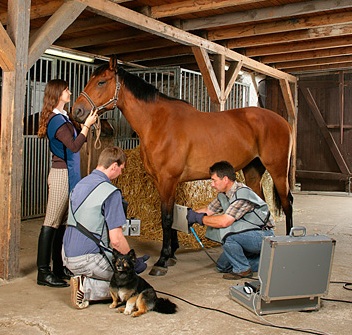Laminitis Laminitis is the detachment of the laminae, a thin tissue deep in the hooves of ungulates, including horses, cattle, and donkeys. This detachment causes pain, lameness, and coffin bone movement, which affects the major bone in the hoof. Laminitis can be fatal if not diagnosed and treated in its earliest stages. (see "Laminitis in Depth" for more information) |
||||
History of Technology There are no previous diagnostic tools before the most recent use of blood tests for insulin levels and x-rays. However, horse owners and veterinarians relied on, and still do, signs and symptoms, including: dropped soles, flat feet, bruised soles, depression, lameness, and a reluctance to move. |
Present Technology Currently, laminitis is being diagnosed using blood tests to check insulin levels. This is important because horses with metabolic disorders have high insulin levels and are more at risk for laminitis. X-rays, venograms (an x-ray of the veins), radiography, and signs and symptoms are also used. These methods are effective, but can be expensive and laborious. Presently, getting a quality x-ray means a sometimes long commute to a properly supplied equine veterinary hospital. This can be uncomfortable for the horse and time-consuming for the owner, which is why we decided to revise this technology. |
 This horse is getting a x-ray. The L.E.A.D.S would have a much smaller portable x-ray and would not require a lead glove or apron, like the x-ray in the picture. |
||